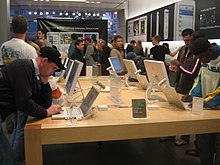1998–2005: Return to profitability
February 11, 2011On August 15, 1998, Apple introduced a new all-in-one computer reminiscent of the Macintosh 128K: the iMac. The iMac design team was led by Jonathan Ive, who would later design the iPod and theiPhone.[58][59] The iMac featured modern technology and a unique design. It sold close to 800,000 units in its first five months.[60]
Through this period, Apple purchased several companies to create a portfolio of professional and consumer-oriented digital production software. In 1998, Apple announced the purchase of Macromedia'sFinal Cut software, signaling its expansion into the digital video editing market.[61] The following year, Apple released two video editing products: iMovie for consumers, and Final Cut Pro for professionals, the latter of which has gone on to be a significant video-editing program, with 800,000 registered users in early 2007.[62] In 2002 Apple purchased Nothing Real for their advanced digitalcompositing application Shake,[63] as well as Emagic for their music productivity application Logic, which led to the development of their consumer-level GarageBand application.[64][65] iPhoto's release the same year completed the iLife suite.[66]

Mac OS X, based on NeXT's OPENSTEP and BSD Unix was released on March 24, 2001, after several years of development. Aimed at consumers and professionals alike, Mac OS X aimed to combine the stability, reliability and security of Unix with the ease of use afforded by an overhauled user interface. To aid users in migrating from Mac OS 9, the new operating system allowed the use of OS 9 applications through Mac OS X's Classic environment.[67]
On May 19, 2001, Apple opened the first official Apple Retail Stores in Virginia and California.[68] later on July 9 they bought Spruce Technologies, a DVD authoring company. The same year, Apple introduced the iPod portable digital audio player. The product was phenomenally successful — over 100 million units were sold within six years.[69][70] In 2003, Apple's iTunes Store was introduced, offering online music downloads for $0.99 a song and integration with the iPod. The service quickly became the market leader in online music services, with over 5 billion downloads by June 19, 2008.[71]
Since 2001 Apple's design team has progressively abandoned the use of translucent colored plastics first used in the iMac G3. This began with the titaniumPowerBook and was followed by the white polycarbonate iBook and the flat-panel iMac.[72][73]
Posted by Shaheer Ahmed.

